
by Sam Lemonick Monday, August 31, 2015
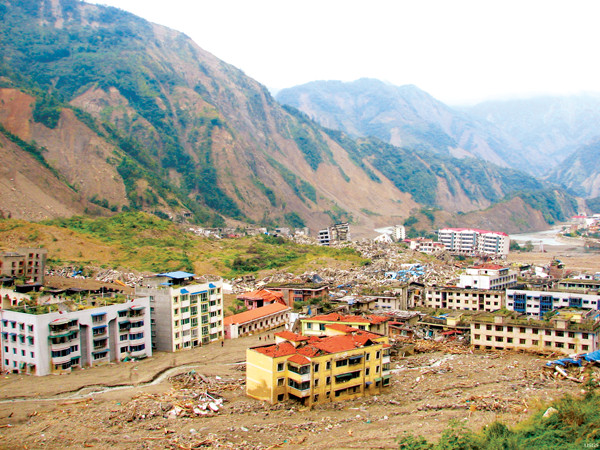
Damage by earthquake-induced landslides in May 2008 was catastrophic and accounted for many casualties. Deadly debris flows hit the town of Qushan, which was destroyed by strong shaking and landslides. Credit: USGS, David Wald.
Just before 2:30 p.m. local time on May 12, 2008, a magnitude-7.9 earthquake shook Sichuan province in Western China. One eyewitness recalls seeing a mountain “blowing up” and boulders two-stories tall crashing into gorges. Another recalls thinking there had been a natural gas explosion, while a third described a hill split in half. It was the country’s largest earthquake in more than 50 years, and it left 18,000 people missing and presumed dead, nearly 375,000 injured and more than 69,000 confirmed fatalities.
Five years later, the wounds have begun to heal: Buildings have been rebuilt and lives are returning to normal. Despite that, deep grief and resentment remain about what locals see as the government’s failure to adequately protect people — especially children — and opinions differ on the success of rebuilding efforts.
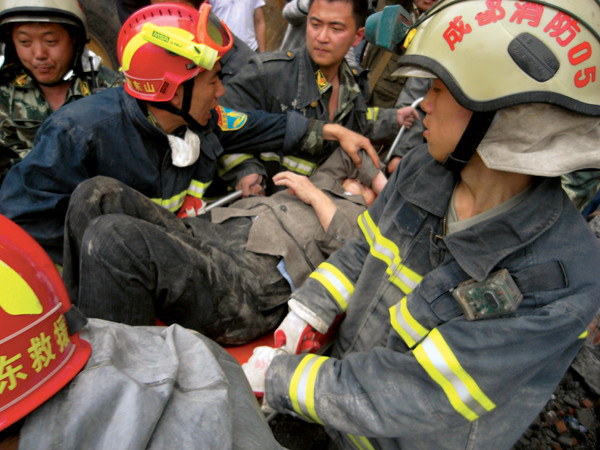
A woman is rescued from the rubble following the Sichuan earthquake, which struck on May 12, 2008. Credit: courtesy of Miniwiki.org, Creative Commons Attribution-ShareAlike 3.0 Unported.
The Sichuan, or Wenchuan, quake struck on the eastern edge of the Tibetan Plateau, in an area with some of the most extreme topography on the planet. The rupture occurred on the Longmenshan Fault, a thrust fault associated with the collision between the Indo-Australian and Eurasian plates; the collision is uplifting Western China at a rate of roughly 5 millimeters a year. Walking across the fault, one would climb nearly 6,000 meters in 50 kilometers from the low-lying Sichuan basin to the tops of the tallest peaks.
The U.S. Geological Survey (USGS) located the epicenter of the quake about 80 kilometers west-northwest of Sichuan’s capital, Chengdu, and about 1,500 kilometers southwest of Beijing. From its hypocenter 19 kilometers below the surface, slip during the earthquake propagated northeast along the fault. According to both seismic data and survivor accounts, the earthquake lasted about two minutes. When the shaking stopped, the two sides of the fault had been offset by nine meters.
Reports of tremors came from thousands of kilometers away in Russia, Taiwan and Thailand, where office buildings reportedly swayed for several minutes. Workers evacuated office buildings in Beijing and in Shanghai, more than 1,600 kilometers away, about the distance from Boston to St. Louis.
Despite its proximity to the epicenter, downtown Chengdu — a city of 6.7 million people — suffered only minor damage. Reporters touring the city after the disaster saw cracks in the walls of buildings, although none had collapsed. In fact, all of the major cities in Sichuan suffered only moderate damage. Meanwhile, some towns in the surrounding countryside were destroyed.
Local and international engineers ascribe this dichotomy in part to China’s adoption of new building codes after a 1976 earthquake in northeast China that killed several hundred thousand people. New construction in China’s fast-growing cities was held to the stricter standards, while older buildings were often not upgraded.
Structures built with brick, mud and other materials before the codes were in place failed, often with tragic results. Among the most visible of these were the many schools that collapsed entirely. News reports worldwide featured heartbreaking pictures of parents who lost their children in devastated school buildings. A year after the quake, the education minister of Sichuan province reported that 5,335 schoolchildren had died in the earthquake.
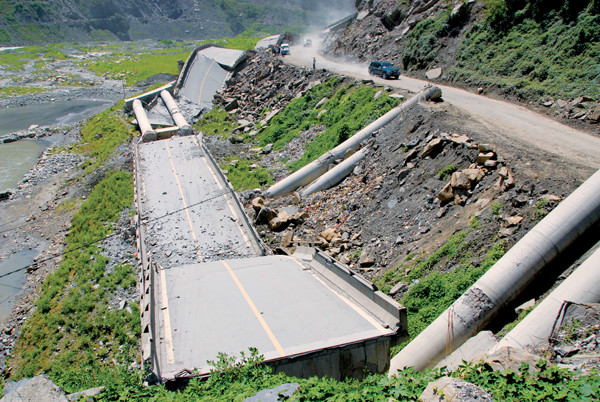
This elevated highway was taken down by the Chinese Army because it was damaged beyond repair by the magnitude-7.9 quake. The road was the main route into the Beichuan area. Credit: USGS, Lynn Highland.
Numerous aftershocks — as many as 100 within the first three days — threatened survivors and delayed rescue efforts in the weeks following the main shock. As late as August, three months after the main shock, the area was hit by a magnitude-6 aftershock.
In addition to the danger of the aftershocks, numerous landslides in the mountainous region blocked rivers, forming 34 so-called quake lakes. The government evacuated hundreds of thousands of people downstream from some of these lakes in fear that the natural dams would burst, and the army airlifted in construction equipment to build sluices to release the water. Some feared that man-made dams might also give way. Despite damage to many, none failed.
Landslides that occurred both during and after the quake severely hampered the relief effort. Bridges and many vital roads were destroyed or covered in rubble. The Chinese military deployed tens of thousands of soldiers within a day of the quake, but they could not reach all of the remote areas most in need of help. One village reportedly spent five days without food and water until a rescue team could reach it.
Relief teams and supplies were flown in from neighboring countries and as far away as the U.S., while money came from around the world. Survivors in Chengdu also made extensive use of the Internet to get information and help coordinate relief and rescue operations.
The Agriculture Ministry reported that among the nonhuman victims of the earthquake were as many as 12.5 million farm animals, mostly chickens. Sichuan is also home to many of the world’s giant pandas, as well as a number of preserves and breeding centers. One panda in captivity died when the wall of its enclosure collapsed after a landslide at the Wolong Nature Reserve. Mud and debris flows also destroyed large swaths of bamboo forest, critical habitat for the wild panda population.
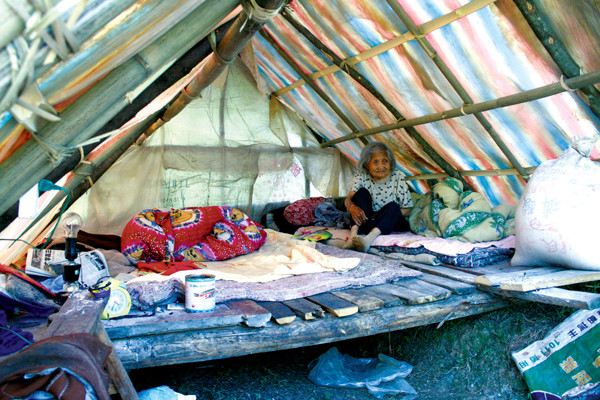
An elderly woman in an emergency shelter after the quake. Credit: USGS.
As was apparent in Italy following the 2009 L’Aquila earthquake, many people expect geologists to be able to predict earthquakes, and the same was true in the aftermath of Sichuan. Many blamed the government for failing to take earthquake predictions seriously, pointing to a 2002 statistical analysis by Chinese seismologist Chen Xuezhong that suggested a strong possibility in the coming years of an earthquake in Sichuan greater than magnitude 7.
But the most contentious issue following the disaster was the charge that by overlooking corruption in the construction of schools, the government had failed to keep Sichuan’s children safe. Ultimately, the government’s tally of collapsed classrooms came to 6,898. Observers were quick to note that many schools collapsed while other nearby buildings suffered little damage.
The updated building codes announced after the 1976 earthquake held schools to an even stricter standard than residential buildings, and the government set out to renovate or rebuild schools that were out of code. After the 2008 quake, parents, journalists, activists and others accused school builders of ignoring the 1976 codes. Chinese critics use the colloquialism “tofu-dreg projects” to describe the shoddy construction of many schools.
An investigation by the Chinese magazine Caijing into why five schools in Sichuan had collapsed found multiple structural failures. Concrete walls, ceilings and floors in the schools had not been reinforced with steel rods called rebar, which gives concrete strength and flexibility, the investigation found. During the earthquake, the concrete simply cracked and crumbled without this internal steel structure.
As one headmaster interviewed by the magazine pointed out, the new schools replaced mud buildings that had leaked in the rain. Prior to the quake, parents and students had been happy to even have a new school, regardless of whether it met earthquake building standards. Bureaucracy, the magazine added, bogged down building inspections.
The Chinese government offered monetary compensation to parents who lost children and lifted its one-child policy for those who had lost an only child. In late May 2008, the government also promised a thorough investigation and severe punishments for construction companies and officials involved in building substandard schools. Despite several further announcements that year indicating the inquiry was in progress, no final report has been announced, at least in Western media. The government has, however, released new, stronger building codes.
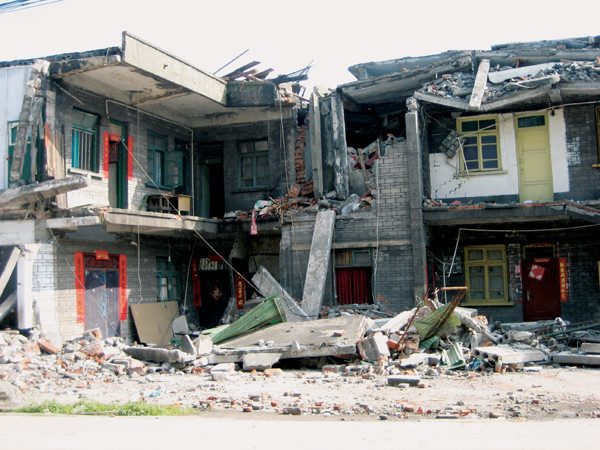
A residential building in Hanwang that was destroyed by the earthquake. Credit: USGS, Sara C. Behan.
Five years after the quake, the Chinese government and mainstream Chinese media have proclaimed “victory” in the rebuilding effort. The government committed $146 billion to relief, rescue and rebuilding. The World Bank reports that the Chinese government commissioned more than 41,000 reconstruction projects and completed 99 percent of them within two years.
In addition, China drew praise for its willingness to accept help from the rest of the world. In particular, the World Bank praised the government’s ability to marshal and direct the combined efforts of agencies, private organizations and individuals. One innovation was to pair counties in unaffected parts of the country with Sichuan counties to help rebuild.
The Chinese government also reformed building codes once again. City layouts were reorganized and damaged hospitals and sanitation plants were modernized. Schools were rebuilt.
Others, however, say that some parts of Sichuan still look like they did five years ago and some people are still living in temporary shelters. One Chinese writer who visited the area near the epicenter last summer reported that many roads remained unrepaired. He wrote that a 26-kilometer car ride took more than three hours because of damaged roads, and suggested the roads are ignored by officials focused on more visible “vanity” projects.
It may ultimately take years before the region fully recovers from the disaster.
In the meantime, the quake continues to be studied by seismologists both in China and around the world. After the quake, the China Geological Survey began a joint project with the USGS to study how to better predict landslide risks. A 2009 study in Science suggested that a dam in Sichuan completed in 2006 might have contributed to the earthquake. The authors proposed that the weight of the impounded water — 320 million metric tons by their estimate — could have altered the pressure on the fault and triggered the earthquake.
If there is a silver lining to the tragedy, it’s that researchers have studied the response to the quake to find better ways to save lives in the future. A study published last year looked at the medical response to the quake, from the initial search for survivors to epidemic outbreak programs in areas that lacked basic sanitation and medical care long after the quake. Experts have pointed to China’s coordinated response — between military and civilian leadership, between national, provincial and local governments, and between affected and unaffected parts of the country — as one of the most successful and important elements in the quake’s aftermath.
© 2008-2021. All rights reserved. Any copying, redistribution or retransmission of any of the contents of this service without the expressed written permission of the American Geosciences Institute is expressly prohibited. Click here for all copyright requests.